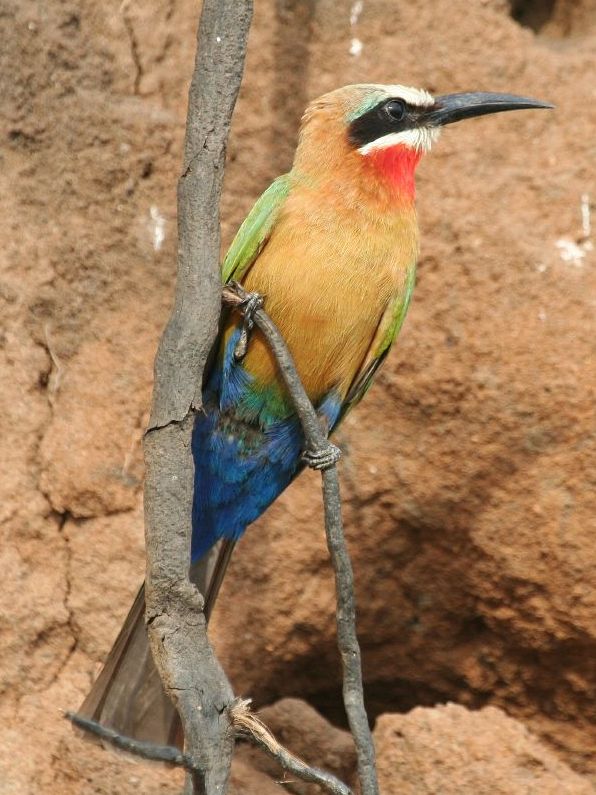|
| 질의: European bee-eater | 결과: 46번째/55 | |
Bee-eater (Family: Meropidae) - Wiki
| 제목: | Bee-eater (Family: Meropidae) - Wiki
| |

| 해상도: 596x795
파일크기: 108953 Bytes
촬영일: 2006:08:06 14:58:15
사진기: Canon EOS 350D DIGITAL (Canon)
F number: f/7.1
Exposure: 1/250 sec
Focal Length: 400/1
등록시간: 2007:09:10 11:11:04
|
Bee-eater
From Wikipedia, the free encyclopedia
[Photo] White-fronted Bee-eater, (Merops bullockoides) in Selous, Tanzania August 2006. Photo by Kuulkers
The bee-eaters are a group of near passerine birds in the family Meropidae. Most species are found in Africa but others occur in southern Europe, Madagascar, Australia and New Guinea. They are characterised by richly coloured plumage, slender bodies and usually elongated central tail feathers. All are colorful and have long downturned bills and pointed wings, which give them a swallow-like appearance when seen from afar.
Just as the expressive name reveals, bee-eaters predominantly eat insects, especially bees, wasps, and other flying insects, which are caught in the air by sallies from an open perch. While they will pursue any type of flying insect, honey bees predominate in their diet. The world range of the bee-eaters is nearly identical to the native world range of the four most common species of honey bees. Fry et al. say "in 20 separate studies of the diet of 16 kinds of bee-eaters, Hymenoptera (ants, bees and wasps) comprised from 20% to 96% of all insects eaten, and honey bees formed on average about one-third of the Hymenoptera".
Before eating its meal, a bee-eater removes the sting by repeatedly hitting the insect on a hard surface. During this process, pressure is applied to the insect thereby extracting most of the venom. Notably, the birds only catch prey that are on the wing and will ignore flying insects once they land.
Bee-eaters are gregarious. They form colonies by nesting in burrows tunneled into the side of sandy banks, such as those which have collapsed on the edges of rivers. Their eggs are white and they generally produce 2-9 eggs per clutch (depending on species), which are widely distributed and common. As they live in colonies, large numbers of these holes are often seen together, white streaks from their accumulated droppings accentuating the entrances to the nests. Most of the species in the family are monogamous, and have biparental care of the young.
The bee-eater family consists of two subfamilies - the bearded bee-eaters Nyctyornithinae (raised to family level as Nyctyornithidae by Charles Sibley in later versions of his computerised world list), and Meropinae, the typical bee-eaters.
Species list in taxonomic order
Family: Meropidae
Red-bearded Bee-eater, Nyctyornis amictus
Blue-bearded Bee-eater, Nyctyornis athertoni
Purple-bearded Bee-eater, Meropogon forsteni
Little Bee-eater, Merops pusillus
Blue-cheeked Bee-eater, Merops persicus
Little Green Bee-eater, Merops orientalis
White-throated Bee-eater, Merops albicollis
Swallow-tailed Bee-eater, Merops hirundinaeus
Blue-tailed Bee-eater, Merops philippinus
Black Bee-eater, Merops gularis
Blue-headed Bee-eater, Merops muelleri
Red-throated Bee-eater, Merops bulocki
White-fronted Bee-eater, Merops bullockoides
Blue-breasted Bee-eater, Merops variegatus
Cinnamon-chested Bee-eater, Merops oreobates
Black-headed Bee-eater, Merops breweri
Somali Bee-eater, Merops revoilii
Boehm's Bee-eater, Merops boehmi
Blue-throated Bee-eater, Merops viridis
Madagascar Bee-eater, Merops superciliosus
Rainbow Bee-eater, Merops ornatus
European Bee-eater, Merops apiaster
Chestnut-headed Bee-eater, Merops leschenaulti
Rosy Bee-eater, Merops malimbicus
Northern Carmine Bee-eater, Merops nubicus
Southern Carmine Bee-eater, Merops nubicoides
http://en.wikipedia.org/wiki/Bee-eater
| The text in this page is based on the copyrighted Wikipedia article shown in above URL. It is used under the GNU Free Documentation License. You may redistribute it, verbatim or modified, providing that you comply with the terms of the GFDL. |
|
댓글 |
|---|
| | 손님 |
|
Scientific Name: Merops bullockoides Smith, 1834
Common Names: White-fronted Bee-eater
French: Guêpier à front blanc German: Weißstirnspint Spanish: Abejaruco frentiblanco
Taxonomy: Merops Bullockoides A. Smith, 1834, Marico district, North West Province, South Africa. |
^o^
동물그림창고 똑똑전화 누리집
^o^
|
|
|

